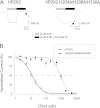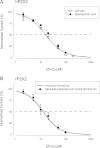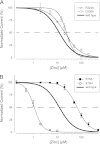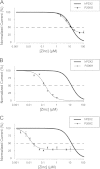High potency zinc modulation of human P2X2 receptors and low potency zinc modulation of rat P2X2 receptors share a common molecular mechanism
- PMID: 22556417
- PMCID: PMC3381168
- DOI: 10.1074/jbc.M112.369157
High potency zinc modulation of human P2X2 receptors and low potency zinc modulation of rat P2X2 receptors share a common molecular mechanism
Abstract
Human P2X2 receptors (hP2X2) are strongly inhibited by zinc over the range of 2-100 μM, whereas rat P2X2 receptors (rP2X2) are strongly potentiated over the same range, and then inhibited by zinc over 100 μM. However, the biological role of zinc modulation is unknown in either species. To identify candidate regions controlling zinc inhibition in hP2X2 a homology model based on the crystal structure of zebrafish P2X4.1 was made. In this model, His-204 and His-209 of one subunit were near His-330 of the adjacent subunit. Cross-linking studies confirmed that these residues are within 8 Å of each other. Simultaneous mutation of these three histidines to alanines decreased the zinc potency of hP2X2 nearly 100-fold. In rP2X2, one of these histidines is replaced by a lysine, and in a background in which zinc potentiation was eliminated, mutation of Lys-197 to histidine converted rP2X2 from low potency to high potency inhibition. We explored whether the zinc-binding site lies within the vestibules running down the central axis of the receptor. Elimination of all negatively charged residues from the upper vestibule had no effect on zinc inhibition. In contrast, mutation of several residues in the hP2X2 middle vestibule resulted in dramatic changes in the potency of zinc inhibition. In particular, the zinc potency of P206C could be reversibly shifted from extremely high (∼10 nM) to very low (>100 μM) by binding and unbinding MTSET. These results suggest that the cluster of histidines at the subunit interface controls access of zinc to its binding site.
Figures









Similar articles
-
Potent and long-lasting inhibition of human P2X2 receptors by copper.Neuropharmacology. 2014 Feb;77:167-76. doi: 10.1016/j.neuropharm.2013.09.001. Epub 2013 Sep 22. Neuropharmacology. 2014. PMID: 24067922 Free PMC article.
-
An intersubunit zinc binding site in rat P2X2 receptors.J Biol Chem. 2005 Jul 15;280(28):25982-93. doi: 10.1074/jbc.M504545200. Epub 2005 May 16. J Biol Chem. 2005. PMID: 15899882 Free PMC article.
-
Salt bridge switching from Arg290/Glu167 to Arg290/ATP promotes the closed-to-open transition of the P2X2 receptor.Mol Pharmacol. 2013 Jan;83(1):73-84. doi: 10.1124/mol.112.081489. Epub 2012 Oct 5. Mol Pharmacol. 2013. PMID: 23041661
-
P2X1 and P2X2 receptors in the central nervous system as possible drug targets.CNS Neurol Disord Drug Targets. 2012 Sep;11(6):675-86. doi: 10.2174/187152712803581128. CNS Neurol Disord Drug Targets. 2012. PMID: 22963438 Review.
-
Molecular Structure and Regulation of P2X Receptors With a Special Emphasis on the Role of P2X2 in the Auditory System.J Cell Physiol. 2016 Aug;231(8):1656-70. doi: 10.1002/jcp.25274. Epub 2015 Dec 30. J Cell Physiol. 2016. PMID: 26627116 Review.
Cited by
-
Potent and long-lasting inhibition of human P2X2 receptors by copper.Neuropharmacology. 2014 Feb;77:167-76. doi: 10.1016/j.neuropharm.2013.09.001. Epub 2013 Sep 22. Neuropharmacology. 2014. PMID: 24067922 Free PMC article.
-
Cloning and characterization of a P2X receptor expressed in the central nervous system of Lymnaea stagnalis.PLoS One. 2012;7(11):e50487. doi: 10.1371/journal.pone.0050487. Epub 2012 Nov 29. PLoS One. 2012. PMID: 23209755 Free PMC article.
-
Regulation of ATP-gated P2X channels: from redox signaling to interactions with other proteins.Antioxid Redox Signal. 2014 Aug 20;21(6):953-70. doi: 10.1089/ars.2013.5549. Epub 2013 Sep 25. Antioxid Redox Signal. 2014. PMID: 23944253 Free PMC article. Review.
-
Zinc transporters and dysregulated channels in cancers.Front Biosci (Landmark Ed). 2017 Jan 1;22(4):623-643. doi: 10.2741/4507. Front Biosci (Landmark Ed). 2017. PMID: 27814637 Free PMC article. Review.
-
Physiological Concentrations of Zinc Have Dual Effects on P2X Myenteric Receptors of Guinea Pig.Cell Mol Neurobiol. 2018 Oct;38(7):1439-1449. doi: 10.1007/s10571-018-0612-7. Epub 2018 Aug 14. Cell Mol Neurobiol. 2018. PMID: 30109516 Free PMC article.
References
Publication types
MeSH terms
Substances
Grants and funding
LinkOut - more resources
Full Text Sources
Molecular Biology Databases

